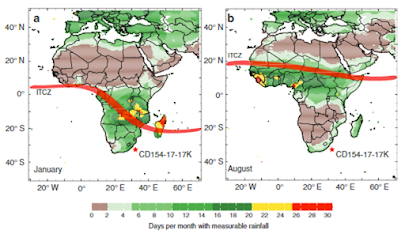The Need To Shift To Irrigated Agriculture
The previous post provided some context on popular narratives about Africa and touched upon the issue of water scarcity. This post will deepen our understanding of rain-fed versus irrigated agriculture across Africa and emphasise the need to intensify irrigation for food security.
Rain-fed
agriculture:
Rain-fed agriculture constitutes nearly 90% of Africa’s food production supply (Cooper and Coe, 2011). Not only is this reliance on precipitation necessary to feed a growing population, but also for poverty reduction as 35% of Africa’s GDP comes from the agricultural sector (Rockström et al., 2010).
Figure 1 – Seasonal variability in
precipitation across Africa due to the ITCZ (red line).
Currently, the Intertropical Convergence Zone (ITCZ) controls seasonal variability in precipitation across Sub-Saharan Africa (Ziegler et al., 2013). Figure 1 shows that countries in South Africa such as Zambia and Botswana experience a rainy season in January during the southern hemisphere summer, whilst remaining relatively dry in August when countries in central tropical Africa such as Niger experience high levels of precipitation. This rainfall also replenishes aquifers and reservoirs, and increases river discharge to increase the presence of surface water and allow people to use it. However, 65% of precipitation across Sub-Saharan Africa is lost by high rates of evapotranspiration (Gabiri et al., 2019). This means that only a fraction of the precipitation is actually stored as surface water or ground water whilst the rest evaporates.
Under climate
change, temperatures are expected to rise up by 3°C (Marshall et al., 2012). Precipitation events will
intensify and variability in rainfall will increase; there will be fewer low
intensity rainfall events whilst there will be more heavier and intense
precipitation events. This variability will either lead to water-surpluses in
some regions such as the tropics, or drought conditions in other regions. If
reductions in rainfall are felt even by 10%, river discharge and surface waters could experience a reduction in storage from 17% to 50% (De Wit and Stankiewicz, 2006) due to already high
rates of evapotranspiration. Thus, this
variability in rainfall could place significant strain on regions that rely on
rain-fed agriculture and affect food security. Perhaps it’s time to move away
from rain-fed agriculture and look to other techniques…
Groundwater for irrigation:
The presence
and availability of groundwater depends on the volume and intensity of rainfall, but primarily depends on underlain geology (Gaye and Tindimugaya, 2019). Figure 2 shows the uneven
distribution of groundwater across Africa and it’s geology. The sedimentary
Sahara basin represents the largest store of groundwater storage in Northern
Africa, storing more than 50 metres of water, but has the lowest recharge rates
of 5 mm per year. It is a fossil aquifer, meaning that they contain fossil water
from up to a million years ago and have very little recharge today. On the
other hand, areas with coastal basins have lower groundwater storages of 1 to
10 metres.
Figure 2 – Maps of groundwater storage, associated
recharge rates and geology across Africa. Left Map. Right Map.
Despite the total
volume of groundwater in Africa estimated to be 0.66 million km3 (MacDonald et al., 2012), only 5% of agriculture in Africa is irrigated (Siebert et al., 2010).
Most of the groundwater is just used for domestic home purposes and as drinking
water. Thus, groundwater represents a promising future for farmers to utilise and
irrigate agriculture with, especially under the threats from climate change. However,
it is imperative that abstracting groundwater remains as sustainable as possible and that aquifers are not degraded or overexploited (MacDonald et al., 2021). Groundwater monitoring will have to constantly occur to make sure that water quality is
maintained and so rapid changes in water quantity and quality can be detected
and mitigated earlier.



Comments
Post a Comment